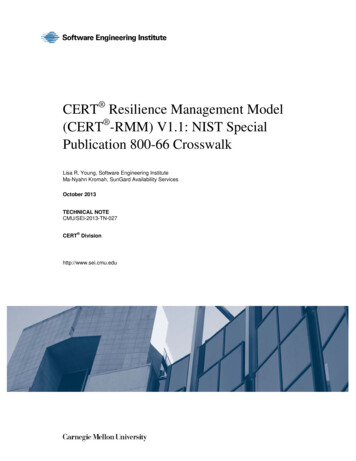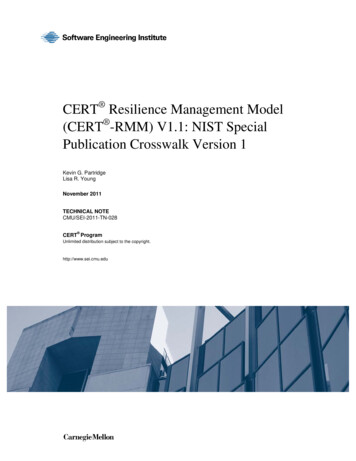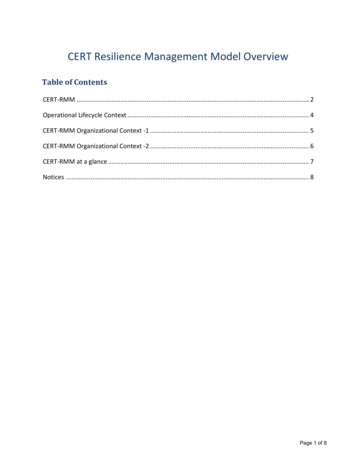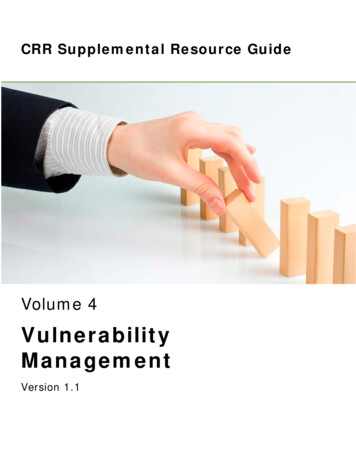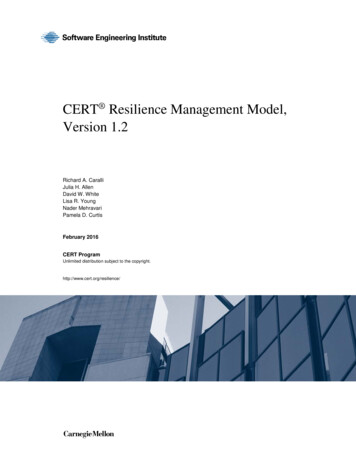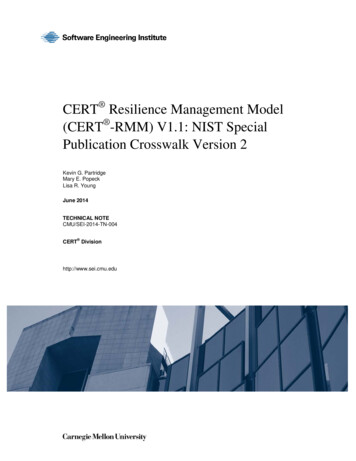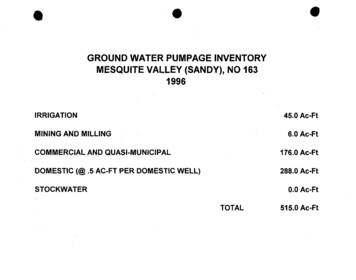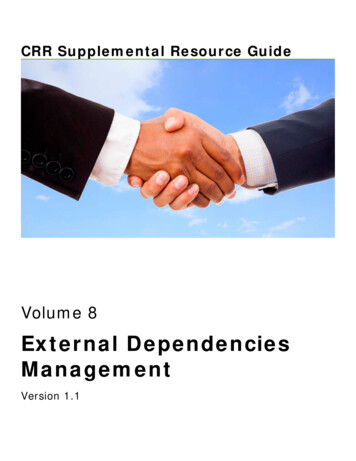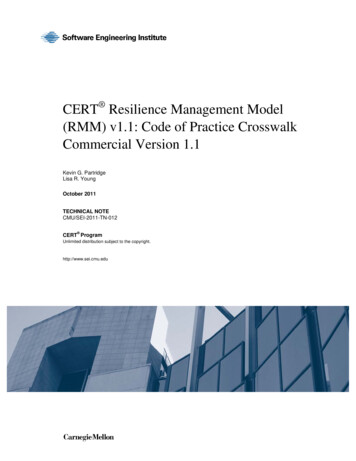
Transcription
CERT Resilience Management Model(RMM) v1.1: Code of Practice CrosswalkCommercial Version 1.1Kevin G. PartridgeLisa R. YoungOctober 2011TECHNICAL NOTECMU/SEI-2011-TN-012 CERT ProgramUnlimited distribution subject to the copyright.http://www.sei.cmu.edu
Copyright 2011 Carnegie Mellon University.This material is based upon work funded and supported by the United States Department of Defense under Contract No.FA8721-05-C-0003 with Carnegie Mellon University for the operation of the Software Engineering Institute, a federallyfunded research and development center.Any opinions, findings and conclusions or recommendations expressed in this material are those of the author(s) and donot necessarily reflect the views of the United States Department of Defense.This report was prepared for theContracting OfficerESC/CAA20 Shilling CircleBuilding 1305, 3rd FloorHanscom AFB, MA 01731-2125NO WARRANTYTHIS CARNEGIE MELLON UNIVERSITY AND SOFTWARE ENGINEERING INSTITUTE MATERIAL ISFURNISHED ON AN “AS-IS” BASIS. CARNEGIE MELLON UNIVERSITY MAKES NO WARRANTIES OF ANYKIND, EITHER EXPRESSED OR IMPLIED, AS TO ANY MATTER INCLUDING, BUT NOT LIMITED TO,WARRANTY OF FITNESS FOR PURPOSE OR MERCHANTABILITY, EXCLUSIVITY, OR RESULTSOBTAINED FROM USE OF THE MATERIAL. CARNEGIE MELLON UNIVERSITY DOES NOT MAKE ANYWARRANTY OF ANY KIND WITH RESPECT TO FREEDOM FROM PATENT, TRADEMARK, OR COPYRIGHTINFRINGEMENT.This material has been approved for public release and unlimited distribution except as restricted below.Internal use:* Permission to reproduce this material and to prepare derivative works from this material for internal use isgranted, provided the copyright and “No Warranty” statements are included with all reproductions and derivative works.External use:* This material may be reproduced in its entirety, without modification, and freely distributed in written orelectronic form without requesting formal permission. Permission is required for any other external and/or commercialuse. Requests for permission should be directed to the Software Engineering Institute at permission@sei.cmu.edu. CERT and CERT Resilience Management Model are registered in the U.S. Patent and Trademark Office by CarnegieMellon University.*These restrictions do not apply to U.S. government entities.SEI MARKINGS V3.2 / 30 AUGUST 2011
Table of ContentsAbstractiii1Introduction1.1 Model Description1.1.1 Features and Benefits of CERT-RMM1.2 Relating CERT-RMM to Standards and Codes of Practice1.2.1 Process Area1.2.2 Process Area - Process Area Goals1.2.3 Process Area Goals - Specific Practices1.2.4 Specific Practices - Subpractices1.2.5 Subpractices - Standards and Common Codes of Practice1112222232Standards and Codes of Practice2.1 ANSI/ASIS SPC.1-20092.2 BS 259992.3 COBIT 4.12.4 CMMI2.5 FFIEC Business Continuity Planning Handbook2.6 ISO/IEC 20000-2:2005 (E)2.7 ISO/IEC 24762:2008 (E)2.8 ISO/IEC 27002:2005 (E)2.9 ISO/IEC 27005:2008 (E)2.10 ISO/IEC 31000:2009 (E)2.11 NFPA 16002.12 PCI DSS44445556666673RMM N-012 i
CMU/SEI-2011-TN-012 ii
AbstractCERT Resilience Management Model (CERT -RMM) provides a reference model that allowsorganizations to make sense of their practice deployment in a process context. In this context, theprimary goal of this document is to help model users and adopters to understand how CERTRMM process areas, industry standards, and codes of practices that are used by organizations inan operational setting are connected. Additionally, this document helps to achieve a primary goalof CERT-RMM, which is to allow adopters to continue to use their preferred standards and codesof practice at a tactical level while maturing management and improvement of operational resilience at a process level. This document was also created with the objective to permit organizationsto use CERT-RMM as a means for managing the complexities of deploying more than one standard or code of practice.CMU/SEI-2011-TN-012 iii
CMU/SEI-2011-TN-012 iv
1 IntroductionThis document is a supplement to the CERT Resilience Management Model (CERT -RMM)v1.1. It is primarily intended to help model users and adopters understand the connection betweenCERT-RMM process areas, industry standards, and codes of practice that are commonly used byorganizations in an operational setting.This document helps to achieve a primary goal of CERT-RMM, which is to allow adopters tocontinue to use their preferred standards and codes of practice at a tactical level while maturingmanagement and improvement of operational resilience at a process level. This document provides a reference for model adopters to determine how their current deployment of practices supports their desired level of process maturity and improvement.Another important objective of this document is to permit organizations to use CERT-RMM as ameans for managing the complexities of deploying more than one standard or code of practice.CERT-RMM provides a reference model that allows organizations to make sense of their practicedeployment in a process context. Thus, issues such as practice overlap and redundancy or the association of a practice to more than one process can be identified and considered to improve processes, reduce practice “quagmires,” and improve effectiveness relative to cost. In essence,CERT-RMM can provide organizations a guide for determining the best practices and selectivelychoosing them based on process improvement goals.1.1Model DescriptionThe CERT-RMM v1.1 is a capability maturity model for managing operational resilience. It hastwo primary objectives: Establish the convergence of operational risk and resilience management activities (securityplanning and management, business continuity, and IT operations and service delivery) intoa single model. Apply a process improvement approach to operational resilience management by definingand applying a capability scale that expresses increasing levels of process maturity.1.1.1Features and Benefits of CERT-RMMCERT-RMM has the following features: provides a process definition, expressed in 26 process areas across four categories—enterprise management, engineering, operations, and process management focuses on the resilience of four essential operational assets: people, information, technology, and facilities includes processes and practices that define a scale of four capability levels for each processarea: incomplete, performed, managed, and defined CERT, CERT Resilience Management Model, and CERT-RMM are registered in the U.S. Patent and Trademark Office by Carnegie Mellon University.CMU/SEI-2011-TN-012 1
serves as a meta-model that easily coexists with and references common codes of practicesuch as ISO2700x, CobiT, BS25999, and ISO24762 includes quantitative process measurements that can be used to ensure operational resilienceprocesses are performing as intended facilitates an objective measurement of capability levels via a structured and repeatable appraisal methodology extends the process improvement and maturity pedigree of CMMI to assurance, security, andservice continuity activitiesA copy of the current version of the CERT Resilience Management Model can be obtained athttp://www.cert.org/resilience.1.2Relating CERT-RMM to Standards and Codes of PracticeCERT-RMM has several key components. The “process area” forms the major structural elementin the model. Each process area has a series of descriptive components.There are two types of practices referred to in CERT-RMM: specific practices and subpractices. Itis important to understand the distinction between these types of practices and the practices contained in common codes of practice in order to make use of this document.1.2.1Process AreaCERT-RMM is comprised of 26 process areas. Each process area describes a functional area ofcompetency. In aggregate, these 26 process areas define the operational resilience managementsystem.1.2.2Process Area - Process Area GoalsEach process area has a set of goals. Goals are required elements of the process area and definethe accomplishment targets of the process that are reflected by the process area. An example of agoal from the Service Continuity process area is “SC:SG1 Prepare for Service Continuity.”1.2.3Process Area Goals - Specific PracticesThe process area goals are decomposed into specific practices. Specific practices are expectedelements of the process area that, when achieved, should promote accomplishment of the associated goal. Specific practices are considered to be the “base practices” of the process area that reflect the area’s body of knowledge. An example of a specific practice from the Service Continuityprocess area is “SC:SG1.SP1 Plan for Service Continuity,” which is a practice aimed at theachievement of goal “SC:SG1 Prepare for Service Continuity.”1.2.4Specific Practices - SubpracticesSpecific practices are decomposed into subpractices. Subpractices are informative elements associated with each specific practice and relevant process work products. Subpractices are a transition point for process area specific practices because the focus changes at this point from “what”must be done to “how.” While not overly prescriptive or detailed, subpractices help the user todetermine how to satisfy the specific practices and achieve the goals of the process area. EachCMU/SEI-2011-TN-012 2
organization will have its own subpractices either organically developed by the organization oracquired from a code of practice.1.2.5Subpractices - Standards and Common Codes of PracticeSubpractices can be linked to standards and codes of practice.1 Subpractices are typically genericin nature, while codes of practice can be very specific. For example, a subpractice may suggest“set password standards and guidelines” while a specific code of practice may state that “passwords should be changed at 90-day intervals.”1Standards and codes of practice are not universally written at the implementation level. Thus, some standardsand codes of practice may include elements of goals, specific practices, and subpractices. However, generallystandards and codes of practice provide implementation details that can be used to actualize CERT-RMM goalsand specific practices, and therefore are considered to be comparable to subpractices in the CERT-RMM model.CMU/SEI-2011-TN-012 3
2 Standards and Codes of PracticeThis section details the standards and codes of practice that have been referenced in this document. These standards and codes are typically in the public domain but may have usage and license restrictions. For ease of use, practices have been referenced by their original numbers, butthere is no restatement of the practice included. Information on obtaining copies of each code ofpractice is included in this section, as each copyright owner (or licensor) is the authoritativesource for the respective standard or code of practice.22.1ANSI/ASIS SPC.1-2009The ANSI/ASIS SPC.1-2009 is the American National Standard on Organizational Resilience:Security, Preparedness, and Continuity Management Systems – Requirements with Guidance forUse [ANSI 2009]. The document is published by ASIS International and approved by the American National Standards Institute, Inc. The standard is designed as an organizational resource tofoster preparedness in anticipation of disruptive incidents. The standard presents guidelines on itsinterpretation of organizational resilience management.The ANSI/ASIS SPC.1-2009 can be obtained in PDF from ASIS online athttp://www.asisonline.org/guidelines/ASIS SPC.1-2009 Item No. 1842.pdf.2.2BS 25999BS 25999 is the British Standards Institution’s (BSI) code of practice and specification for business continuity management. The purpose of the standard is to provide a basis for understanding,developing, and implementing business continuity within an organization and to provide confidence in the organization’s dealings with customers and other organizations.There are two BS 25999 documents: the code of practice, BS 25999-1:2006 [BSI 2006], and thespecification, BS 25999-2: 2007 [BSI 2007]. The code of practice was used for the crosswalk inthis document.British Standards can be obtained in PDF or hard copy format from the BSI online shop athttp://www.bsigroup.com/Shop. Hard copies can also be obtained by contacting BSI CustomerServices at 44 (0)20 8996 9001 or cservices@bsigroup.com.2.3COBIT 4.1COBIT is the Control Objectives for Information and Related Technology [ITGI 2007]. It wasdeveloped by the Information Systems Audit and Control Association (ISACA) and the IT Governance Institute (ITGI) to provide managers, auditors, and IT users with generally accepted in-2The copyright owners of the codes of practice have not participated in the creation or review of CERT RMM orthis Code of Practice Crosswalk. Accordingly, the inclusion of a particular standard or code of practice in thisCode of Practice Crosswalk is not an endorsement or validation of the Software Engineering Institute, CERTRMM or this Code of Practice Crosswalk by such copyright owner, and all references to such codes of practiceshould be read as qualified by the actual codes of practice.CMU/SEI-2011-TN-012 4
formation technology control objectives to maximize IT benefits and ensure appropriate IT governance, security, and control.COBIT 4.1 is the current version and was used in this crosswalk document. Further informationregarding the implementation of COBIT 4.1, including copies of the current version, can be obtained by visiting http://www.isaca.org and http://www.itgi.org.2.4CMMICapability Maturity Model Integration (CMMI )3 is a process improvement maturity model forthe development of products and services. The CMMI for Development (CMMI-DEV) representsthe systems and software development domain [CMMI 2006]. The CMMI for Services (CMMISVC) constellation is designed to cover the activities required to manage, establish, and deliverservices [CMMI 2009].CMMI for Development v1.2 is used in this document and is referenced as CMMI-DEV. It can beobtained at 6tr008.cfm. CMMI for Servicesv1.2 is used in this document and can be obtained /09tr001.cfm. It is referenced as CMMI-SVCthroughout this document.2.5FFIEC Business Continuity Planning HandbookThe Federal Financial Institutions Examination Council (FFIEC) publishes a series of bookletsthat comprise the FFIEC Information Technology Examination Handbook. These booklets arepublished to help bank examiners to evaluate financial institutions and service provider risk management processes with the goal of ensuring the availability of critical financial services.The FFIEC Business Continuity Planning booklet [FFIEC 2008] was used for reference in thiscode of practice crosswalk. In the future, the FFIEC Information Security booklet will be referenced as well. FFIEC booklets can be obtained athttp://www.ffiec.gov/ffiecinfobase/html pages/it 01.html.2.6ISO/IEC 20000-2:2005 (E)ISO/IEC 20000 is a standard and code of practice for IT service management published by theInternational Organization for Standardization and the International Electrotechnical Commission(ISO/IEC). It is based on (and supersedes) the earlier British Standard BS 15000. It reflects thebest practice guidance for IT service management as provided in the ITIL (Information Technology Infrastructure Library) framework, but also broadly covers other service management standards.The ISO/IEC 20000-2:2005 code of practice [ISO/IEC 2005a] was used in this crosswalk document. The standard ISO/IEC 20000-1:2005 and the code of practice ISO/IEC 20000-2:2005 canbe purchased from ANSI at http://webstore.ansi.org/.3Capability Maturity Model and CMMI are registered in the U.S. Patent and Trademark Office by CarnegieMellon University.CMU/SEI-2011-TN-012 5
2.7ISO/IEC 24762:2008 (E)ISO/IEC 24762, “Guidelines for information and communications technology disaster recoveryservices” [ISO/IEC 2008a], is part of business continuity management standards published byISO/IEC. It can be applied in-house or to outsourced providers of DR physical facilities and services.The current version of the standard, ISO/IEC 24762:2008, can be purchased from ANSI athttp://webstore.ansi.org/.2.8ISO/IEC 27002:2005 (E)ISO/IEC 27002, “Code of practice for information security management” [ISO/IEC 2005b],broaches the full scope of security management, at points touching upon both IT management anddisaster recovery. ISO/IEC 27002 is part of a growing “27000 series” that evolved from the original British Standard BS 7799, which was translated to ISO standard ISO 17799.The current version of the code of practice, ISO/IEC 27002:2005, can be purchased from ANSI athttp://webstore.ansi.org/.2.9ISO/IEC 27005:2008 (E)ISO/IEC 27005, “Information technology – Security techniques – Information security risk management” [ISO/IEC 2008b], is also a British Standard derivation. ISO/IEC 27005 is based uponBS 7799-3:2006. The standard describes a risk management process specific to information security and analysis of that risk.The current version of the code of practice, ISO/IEC 27005:2008, can be purchased from ANSI athttp://webstore.ansi.org/.2.10 ISO/IEC 31000:2009 (E)ISO/IEC 31000, “Risk Management – Principles and Guidelines” [ISO/IEC 2009], is anotherstandard published by ISO/IEC and, as mentioned, is distinct from ISO/IEC 27005. ISO/IEC31000 deviates from the British Standard origin of the preceding standards. ISO/IEC is derivedfrom the Standards Australia and Standards New Zealand document: AS/NZS 4360:2004. Thisstandard is a set of best practices and guidelines for the development of a risk managementframework. The framework guidance is organizational in scope and focuses on the managementof perceptible risk and risk tolerance.The current version of the code of practice, ISO/IEC 31000:2009, can be purchased from ANSI athttp://webstore.ansi.org/.2.11 NFPA 1600NFPA 1600 is the National Fire Protection Agency Standard on Disaster/Emergency Managementand Business Continuity Programs [NFPA 2007]. It is primarily focused on the development, implementation, and operation of disaster, emergency, and business continuity programs, includingthe development of various types of related plans. The 2007 edition of this standard was used forreference and is an update of the 2004 standard.CMU/SEI-2011-TN-012 6
The standard can be obtained at the NFPA website at http://www.nfpa.org.2.12 PCI DSSPCI DSS is the Payment Card Industry Data Security Standard that evolved from security effortsby major credit card organizations [PCI 2009]. It is intended to provide a data security standardfor merchants and card payment service providers and processors to prevent fraud and controlvulnerabilities. Compliance with the standard is validated through assessments performed by PCIDSS-qualified assessors.The current standard version is 1.2.1.4 It can be downloaded athttp://www.pcisecuritystandards.org.4Payment Card Industry (PCI) Data Security Standard, Version 1.1 (Release: September 2006) provided courtesy of PCI Security Standards Council, LLC and/or its licensors. 2007 PCI Security Standards Council, LLC.All Rights Reserved.CMU/SEI-2011-TN-012 7
3 RMM CrosswalkCommercial Standards and PracticesCERT ResilienceManagement Modelv1.1Process Area SpecificGoals and CCOBITFFIEC book2005 (E)2008 (E)2005 (E)2008 (E)2009 (E)16002009ADM – Asset Definition and ManagementADM:SG1 EstablishOrganizational tices9.1.25.3.3ADM:SG1.SP1 Inventory1.Identify and inventoryvital staff.2.Identify and inventoryhigh-value informationassets.3.Identify and inventoryhigh-value technologycomponents.4.Identify and inventoryhigh-value facilities.5.Develop and maintain anasset database thatestablishes a commonsource for all EI-2011-TN-012 8
Commercial Standards and PracticesCERT ResilienceManagement Modelv1.1Process Area SpecificGoals and SpecificPracticesADM:SG1.SP2 Establish ACommon UnderstandingSubpractices1.Create an asset profile foreach asset (or similarwork product) anddocument a commondescription.2.Describe and documentthe “acceptable use” ofthe asset. Ensurealignment betweenacceptable uses andresilience requirements.3.Classify informationassets as to their level ofsensitivity.4.Update the assetdatabase with assetprofile TFFIEC book2005 (E)2008 (E)2005 (E)2008 (E)2009 33.27.2.112.310.1.1CMU/SEI-2011-TN-012 9
Commercial Standards and PracticesCERT ResilienceManagement Modelv1.1Process Area SpecificGoals and SpecificPracticesADM:SG1.SP3 BITFFIEC book2005 (E)2008 (E)2005 (E)2008 (E)2009 1.21.1.8Ownership andCustodianshipSubpractices1.Document and describethe owner of each asseton the asset profile (orsimilar work product).2.Group assets that arecollectively needed toperform a specificbusiness process orservice, and identifyservice owners, ifnecessary.3.Document and describethe physical location ofthe asset and thecustodian of the asset.6.6.212.3.87.1.211.6.2CMU/SEI-2011-TN-012 10
Commercial Standards and PracticesCERT ResilienceManagement Modelv1.1Process Area SpecificGoals and CCOBITFFIEC book2005 (E)2008 (E)2005 (E)2008 (E)2009 (E)16002009ADM:SG2 Establish theRelationship BetweenAssets and ServicesADM:SG2.SP1 AssociateAssets with ntify high-valueservices.2.Assign assets in the assetdatabase to one or moreservices.3.Update asset profiles toestablish and documentthe asset’s association toa service.4.Update the assetdatabase with asset-toservice -2011-TN-012 11
Commercial Standards and PracticesCERT ResilienceManagement Modelv1.1Process Area SpecificGoals and SpecificPracticesADM:SG2.SP2 AnalyzeAsset-Service TFFIEC book2005 (E)2008 (E)2005 (E)2008 (E)2009 1.2Subpractices1.Identify assetdependencies andpotential conflicts.2.Develop mitigation plansto reduce the effects ofdependencies that couldaffect the operationalresilience of associatedservices.3.Implement actions toreduce or eliminateconflict.ADM:SG3 Manage AssetsADM:SG3.SP1 IdentifyChange CriteriaSubpractices1.2.Establish an assetinventory baseline fromwhich changes will .26.1.54.1.3Develop and documentcriteria for establishingwhen a change in assetinventory must beconsidered.CMU/SEI-2011-TN-012 12
Commercial Standards and PracticesCERT ResilienceManagement Modelv1.1Process Area SpecificGoals and SpecificPracticesADM:SG3.SP2 CISO/IECCOBITFFIEC book2005 (E)2008 (E)2005 (E)2008 (E)2009 (E)16002009PO10.114.1.27.149.2.66.1.5Changes to Assets andInventorySubpractices1.Document the assetchanges by updatingasset profiles and theasset database.2.Maintain a requirementchange history withrationale for performingthe changes.3.Evaluate the impact ofasset changes on existingresilience requirementsand activities andcommitments forprotecting and sustainingassets.4.Establish communicationchannels to ensurecustodians are aware ofchanges in assets.4.1.46.1.75.2CMU/SEI-2011-TN-012 13
Commercial Standards and PracticesCERT ResilienceManagement Modelv1.1Process Area SpecificGoals and CCOBITFFIEC book2005 (E)2008 (E)2005 (E)2008 (E)2009 (E)16002009AM – Access ManagementAM:SG1 Manage andControl AccessAM:SG1.SP1 Enable s,and Processes5.7.36.3.1-7Establish accessmanagement policies andprocedures.2.Complete and submitaccess requests.3.Approve access requests.6.12.14.Provide users [accessholders] with a writtenstatement of their accessrights andresponsibilities.5.Implement 15.1.515.3.2CMU/SEI-2011-TN-012 14
Commercial Standards and PracticesCERT ResilienceManagement Modelv1.1Process Area SpecificGoals and SpecificPracticesAM:SG1.SP2 ManageChanges to Access O/IECISO/IECCOBITFFIEC book2005 (E)2008 (E)2005 (E)2008 (E)2009 (E)16002009DS5.4PO7.8DS12.3Establish an enterprisewide changemanagement process foraccess privileges.OtherPolicies,Standards,and 7.2.67.5.411.2,312.5.87.5.511.5.4Establish organizationalcriteria that may signifychanges in accessprivileges.12.3.215.3.2Manage changes toaccess privileges.AM:SG1.SP3 1.2.47.5.312.3.27.5.415.3.2Review and Maintain AccessPrivilegesSubpractices1.Establish regular reviewcycle and process.2.Perform periodic reviewof access privileges byasset.3.Identify inconsistenciesor misalignments inaccess privileges.CMU/SEI-2011-TN-012 15
Commercial Standards and PracticesCERT ResilienceManagement Modelv1.1Process Area SpecificGoals and SpecificPracticesAM:SG1.SP4 CorrectInconsistenciesSubpractices1.Develop correctiveactions to addressexcessive orinappropriate levels ofaccess privileges.2.Correct access privilegesas required.3.Document disposition forexcessive orinappropriate levels ofaccess privileges that willnot result in changes ordeprovisioning.4.Identify risks related toexcessive orinappropriate levels ofaccess privileges.5.Update status oncorrective EC book2005 (E)2008 (E)2005 (E)2008 (E)2009 2011-TN-012 16
Commercial Standards and PracticesCERT ResilienceManagement Modelv1.1Process Area SpecificGoals and CCOBITFFIEC book2005 (E)2008 (E)2005 (E)2008 (E)2009 (E)16002009COMM – CommunicationsCOMM:SG1 Prepare forResilience CommunicationsCOMM:SG1.SP1 IdentifyRelevant StakeholdersSubpractices1.Identify relevantstakeholders that mayhave a vested interest orvital role incommunications aboutresilience.2.Establish a plan thatdescribes theinvolvement of O6.5AppendixG: BCPComponents5.1.45.2.96.3.8CMU/SEI-2011-TN-012 17
Commercial Standards and PracticesCERT ResilienceManagement Modelv1.1Process Area SpecificGoals and SpecificPracticesCOMM:SG1.SP2 alyze the resilienceprogram to identify thetypes and extent ofcommunication that isnecessary to satisfyresilience programobjectives.2.Document thecommunications needs ofstakeholders.3.Establish communicationsrequirements for theoperational resiliencemanagement processes.4.Analyze and prioritizecommunicationrequirements.5.Revise thecommunication needs ofthe organization aschanges to the resilienceprogram and strategy SO/IECCOBITFFIEC book2005 (E)2008 (E)2005 (E)2008 (E)2009 (E)16002009OtherPolicies,Standards,and ProcessesAppendixG: 1-TN-012 18
Commercial Standards and PracticesCERT ResilienceManagement Modelv1.1Process Area SpecificGoals and COMM:SG1.SP3 Establish8.5.5Communications GuidelinesDS5.11and IECISO/IECISO/IECISO/IECCOBITFFIEC book2005 (E)2008 (E)2005 (E)2008 (E)2009 (E)16002009OtherPolicies,Standards,and Processes5.8.3AppendixG: BCPComponents5.8.35.2.96.3.3Subpractices1.Develop resiliencecommunicationguidelines and standards.COMM:SG2 Prepare forCommunicationsManagementCOMM:SG2.SP1 Establish aResilience CommunicationsPlanSubpractices1.Develop and implement aresiliencecommunications plan.2.Establish commitmentsto the communicationsplan.3.Revise the plan andcommitments .3.76.4.6CMU/SEI-2011-TN-012 19
Commercial Standards and PracticesCERT ResilienceManagement Modelv1.1Process Area SpecificGoals and SpecificPracticesCOMM:SG2.SP2 Establish aResilience 20064.4.2CMMI-DevCMMI-SvcISO/IECISO/IECISO/IEC
CERT-RMM can provide organizations a guide for determining the best practices and selectively choosing them based on process improvement goals. 1.1 Model Description The CERT-RMM v1.1 is a capability maturity model for managing operational resilience. It has two primary objectives:
